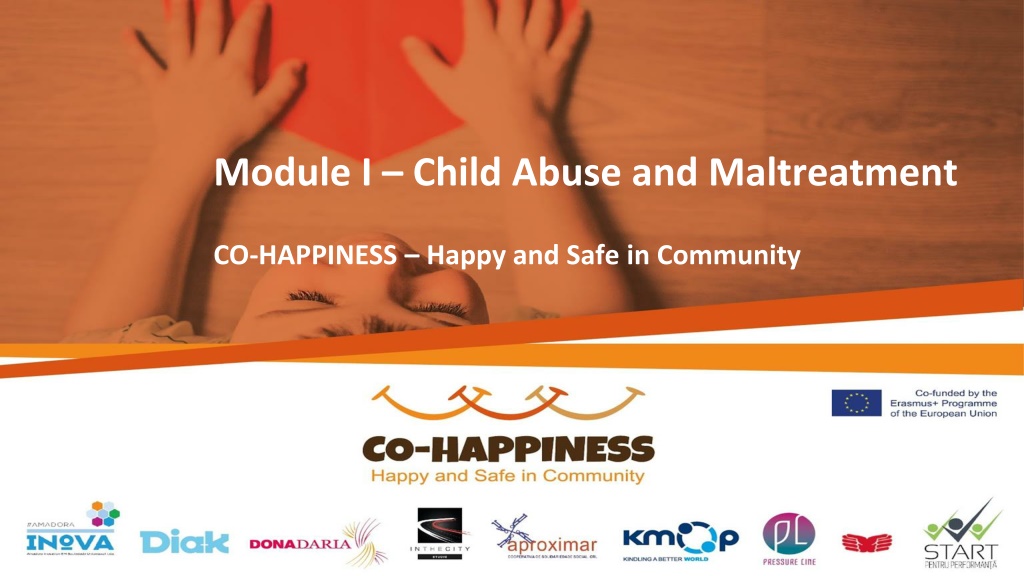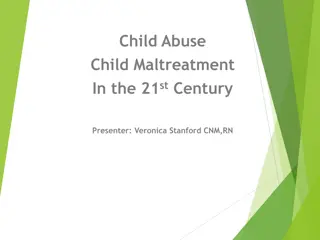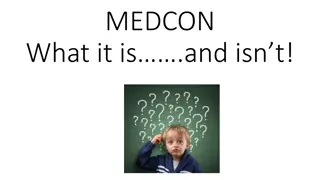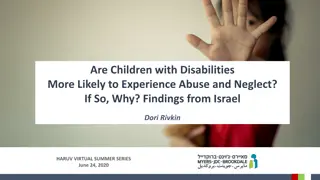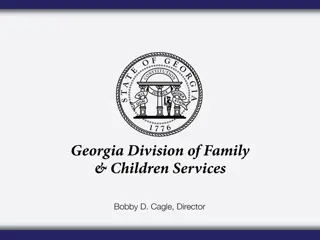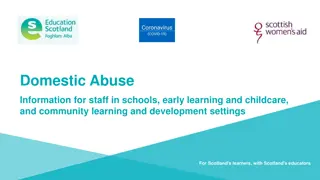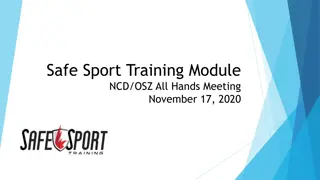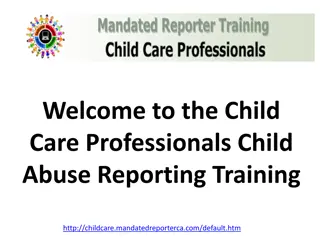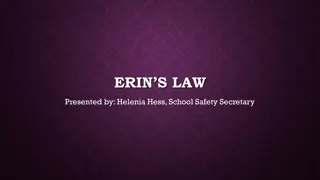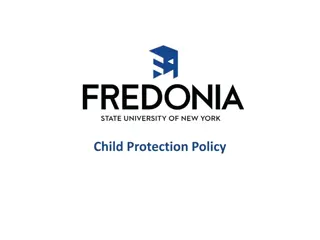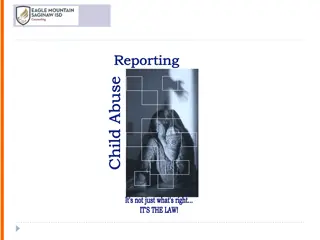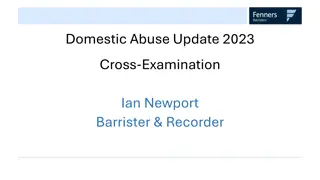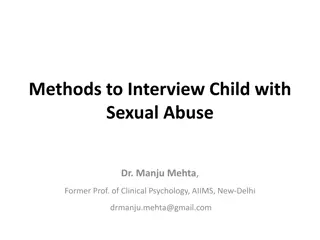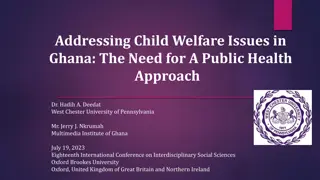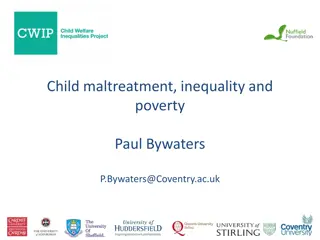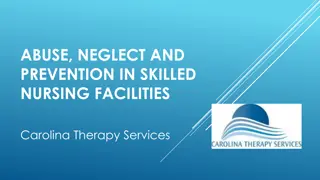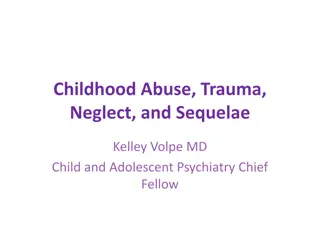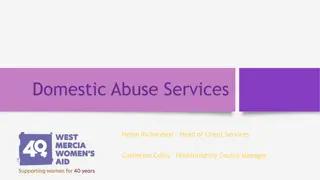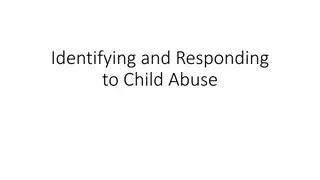Understanding Child Abuse and Maltreatment Module
This module aims to clarify the definitions of child abuse and maltreatment, increase understanding of different forms of abuse, recognize signs of abuse, and understand victims' needs. Learners will define child abuse, identify signs of abuse, and comprehend mental trauma mechanisms in children and adolescents. Key facts highlight the prevalence and consequences of child maltreatment, emphasizing prevention and ongoing support for at-risk children and families.
Download Presentation

Please find below an Image/Link to download the presentation.
The content on the website is provided AS IS for your information and personal use only. It may not be sold, licensed, or shared on other websites without obtaining consent from the author. Download presentation by click this link. If you encounter any issues during the download, it is possible that the publisher has removed the file from their server.
E N D
Presentation Transcript
Module I Child Abuse and Maltreatment Module I Child Abuse and Maltreatment CO-HAPPINESS Happy and Safe in Community
Aim of Module 1 The aim of this module is to - - Clarify the definitions of different forms of child abuse and maltreatment Increase the understanding of the various forms of child abuse and maltreatment through theretical framework as well as how to recognice abuse The aim is also to increase understanding about the needs the victimes of abuse has -
Learning outcomes After completing this module learners should be able to - Define the consept of child abuse and maltreatment - Name the forms of abuse and maltreatment and identify signs revealing abuse and maltreatment - Understand the mechanism of child and adolecent mental trauma
Content 1. What is child abuse? 1. Definition of different types of abuse and maltreatment 1. Research evidence and riskfactors 1. Epidemiology
Key facts - 5 children die every day as a result of child abuse - One in 5 women and 1 in 13 men report having been sexually abused as a child - Consequences of child maltreatment include impaired lifelong physical and mental health - Preventing child maltreatment requires a multisectoral approach - Effective prevention programs support parents and teach positive parenting skills - Ongoing care of children and families can reduce the risk of maltreatment reoccurring and can minimize its consequences.
Definition of Child abuse In 1999, the WHO Consultation on Child Abuse Prevention compared definitions of abuse from 58 countries and drafted the following definition: Child abuse or maltreatment constitutes all forms of physical and/or emotional ill-treatment, sexual abuse, neglect or negligent treatment or commercial or other exploitation, resulting in actual or potential harm to the child s health, survival, development or dignity in the context of a relationship of responsibility, trust or power.
Definition of child abuse Child Welfare Act The physical or mental injury, sexual abuse or exploitation, negligent treatment, or maltreatment of a child under the age of 18 by a person who is responsible for the child s welfare under circumstances which indicate that the child s health or welfare is harmed or threatened.
Definition of child abuse Child Welfare Act The physical or mental injury, sexual abuse or exploitation, negligent treatment, or maltreatment of a child under the age of 18 by a person who is responsible for the child s welfare under circumstances which indicate that the child s health or welfare is harmed or threatened.
Definition of child abuse Other definition Any behavior directed toward a child that endangers or impairs a child s physical or emotional health and development
Main types of Child Abuse - physical abuse - sexual abuse - emotional abuse - neglect
Physical Abuse Physical abuse is any non-accidental injury World Health Organization (WHO): Acts that result in actual or potential physical harm, resulting from an interaction that is within the control of a parent or person in a position of responsibility, power or trust UNICEF: Persons under 18 years of age who suffer occasional or habitual acts of violence to a child under the age of 18 by a parent or caretaker. These injuries may include beatings, shaking, burns, human bites, strangulation, or immersion in scalding water or others, with resulting bruises and welts, fractures, scars, burns, internal injuries or any other injuries.
Sexual Abuse Sexual abuse occurs when a person uses power over a child, and directly involves the child in any sexual act, involves the child in pornography, or forces the child to witness sexual acts. Involvement of a child in sexual activity that he/she does not fully comprehend, is not able to give consent to, and that violates the laws or taboos of society.
Sexually Abusive behaviors Voyeurism Sodomy Fondling Oral-genital stimulation Child prostitution Verbal stimulation Child pornography Exhibitionism Intercourse
Emotional Abuse Failure to provide a developmentally appropriate, supportive environment, so that a child can establish a stable and full range of emotional and social competencies commensurate with his or her personal potential .
Neglect Failure to provide for a child in all domains: physical and mental health, education, nutrition, shelter, and safe living conditions, when the resources are reasonably available to the family or caretakers. The difference between abuse and neglect is that abuse represents an action against a child while neglect represents a lack of action for the child.
Research evidence What aspects makes a difference: Who committed the abuse; effects are generally worse when it was a parent, step-parent or trusted adult than a stranger Age of the child when the abuse happened : younger is usually more harmful Trusted person s response when confiding: doubting, ignoring, blaming and shaming responses can be extremely harmful - even more than the abuse itself Whether or not violence was involved, and if so, how severe, how long the abuse went on Continues
Whether the abuse involved deliberately humiliating the child How "normal" such abuse was in the extended family and local culture Whether the child had loving family members, and/or knew that someone loved her or him Whether the child had some good relationships - with siblings, friends, teachers, coaches, etc. Whether the child had any relationships in which "negative" feelings were acceptable, and could be expressed and managed safely and constructively
Riskfactors for child abuse Parent-related Personal history of physical or sexual abuse as a child Teenage parents, Single parent Emotional immaturity, Lack of parenting skills Poor coping skills , Low self-esteem Personal history of substance abuse Known history of child abuse Lack of social support, Lack of preparation having a new infant (multiple young children) Domestic violence History of depression or other mental health problems Unwanted pregnancy, Denial of pregnancy Community/societal High crime rate Lack of or few social services High poverty rate High unemployment rate Child-related Prematurity Low birth weight Handicap
Recent studies on epidemiology Germany 2016: 2510 participants, ages of 14 and 94 years in 2016 over 10% of participants reported at least moderate emotional neglect more than 20% at least moderate physical neglect Balkan region Albania, Bosnia and Herzegovina, Bulgaria, Croatia, the Former Yugoslavian Republic of Macedonia, Greece, Romania, Serbia, and Turkey 42,194 children at the ages of 11, 13 and 16 years participated For all countries, over 50% of the sample reported a lifetime prevalence for both experiencing psychological and physical violence. continues..
Epidemiology... Canadian researchers had a pioneering role in collecting incidence data on reported child maltreatment. The findings show a decrease in rates of reported child sexual abuse Policy changes had an obvious impact on incidence rates: A new category risk of future maltreatment helps to identify and support families before violance happens Lessons learned in Switzerland: by valuing agencies context-specific knowledge and expertise instead of viewing them as mere providers of data it came possible to collect accurate data of the number on child maltreatment and abuse incidents. Data collecting happened in co operation between researchers and child protection practitioners Model highly recommended to all countries
References Fallon, B, Trocm N, Filippelli J, Black T, Joh-Carnella N. Responding to safety concerns and chronic needs: trends over time.Child Adolesc Psychiatry Ment Health. 2017; 11():60. Nikolaidis G, Petroulaki K, Zarokosta F, Tsirigoti A, Hazizaj A, Cenko E, et al. Lifetime and past-year prevalence of children s exposure to violence in 9 Balkan countries: the BECAN study. Child Adolesc Psychiatry Ment Health. 2018;12:1. DOI: 10.1186/s13034-017-0208-x .Jud A, Kosirnik C, Mitrovic T, Ben Salah H, Fux E, Koehler J, Portmann R, Kn sel R. Mobilizing agencies for incidence surveys on child maltreatment: successful participation in Switzerland and lessons learned. Child Adolesc Psychiatry Ment Health. 2018; 12():3. Trevor Spratt, Jachen Nett, Leah Bromfield, Johanna Hietamaki,Heinz Kindler, Lina Ponnert. Child Protection in Europe: Development of an International Cross-Comparison Model to Inform National Policies and Practices. British Journal of Social Work (BR J SOC WORK), Jul2015; 45(5): 1508-1525. DOI: http://dx.doi.org/bjsw/bcu109 WHO. Child maltretment. https://www.who.int/news-room/fact-sheets/detail/child-maltreatment Witt A, Brown RC, Plener PL, Br hler E, Fegert JM. Child maltreatment in Germany: prevalence rates in the general population. Child Adolesc Psychiatry Ment Health. 2017;11:47. doi: 10.1186/s13034-017-0185-0 Noora Ellonen, Kirsi Peltonen, Tarja P s , Staffan Janson. A Multifaceted Risk Analysis of Fathers Self-Reported Physical Violence Toward Their Children. Aggressive Behavior. Jul2017, Vol. 43 Issue 4, p317-328. 12p. 3 Charts, 1 Graph. DOI: 10.1002/ab.21691 Wail Rehan, Jan Antfolk, Ada Johansson, Patrick Jern,Pekka Santtila. Experiences of severe childhood maltreatment, depression, anxiety and alcohol abuse among adults in Finland. PLoS ONE. 5/8/2017, Vol. 12 Issue 5, p1-12. 12p. DOI: 10.1371/journal.pone.0177252. Kloppen, Kathrine, M hle, Magne, Kvello, yvind, Haugland, Siren, Breivik, Kyrre. Prevalence of Intrafamilial Child Maltreatment in the Nordic countries: A Review. Child Abuse Review. Jan/Feb2015, Vol. 24 Issue 1, p51-66. 16p. 4 Charts. DOI: 10.1002/car.2324.
Kim, Kihyun,Mennen, Ferol E. Trickett, Penelope K. Patterns and correlates of co-occurrence among multiple types of child maltreatment. Child & Family Social Work (CHILD FAM SOC WORK), Feb2017; 22(1): 492-502. DOI: http://dx.doi.org/10.1111/cfs.12268 Trevor Spratt, Jachen Nett, Leah Bromfield, Johanna Hietamaki, Heinz Kindler, Lina Ponnert. Child Protection in Europe: Development of an International Cross-Comparison Model to Inform National Policies and Practices. British Journal of Social Work (BR J SOC WORK), Jul2015; 45(5): 1508-1525. DOI: http://dx.doi.org/bjsw/bcu109. Barlow, Jane, Basarab-Horwath, Janet Anne, Woodman, Jenny, Turnell, Andrew, Kennedy, Hilary, Gorin, Sarah, Bunn, Amanda, Allnock, Debra, McAllister, Jan, Gardner, Ruth. Tackling Child Neglect : Research, Policy and Evidence-Based Practice. London : Jessica Kingsley Publishers. 2016. Alexander, Randell. Research and Practices in Child Maltreatment Prevention, Volume 1, Definitions of abuse and prevention. Florissant, MO : STM Learning. 2017. Alexander, Randell. Research and Practices in Child Maltreatment Prevention, Volume 2, Societal, organizational, and international approaches. Florissant, MO : STM Learning. 2017. Feit, Monica N., Joseph, Joshua, Petersen, Anne C. New Directions in Child Abuse and Neglect Research. Washington, District of Columbia : National Academies Press. 2014.
